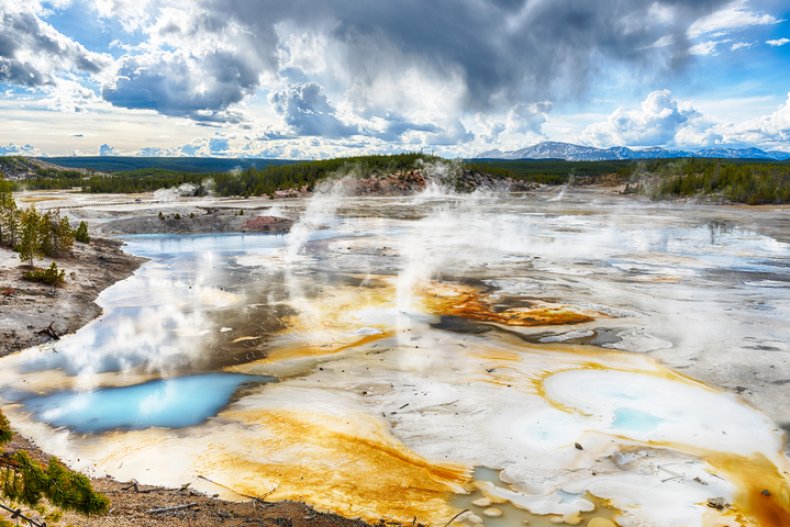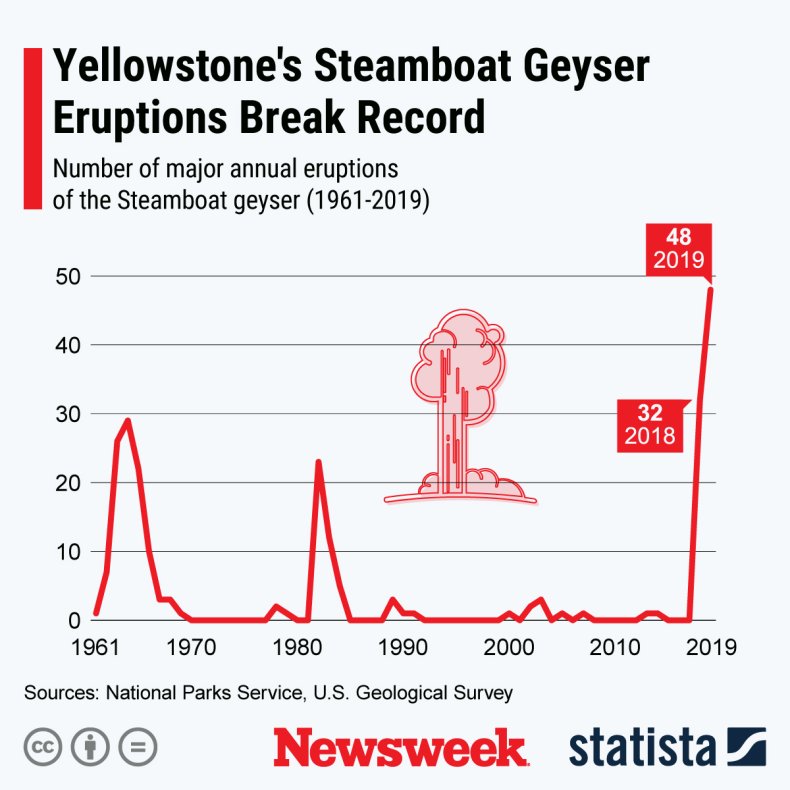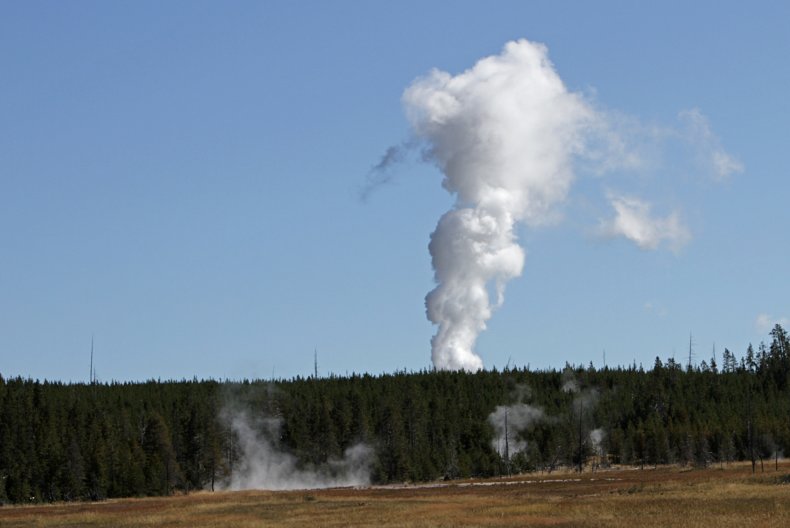BY HANNAH OSBORNE ON 3/12/20
In 2013, an area of the Yellowstone supervolcano started rising at an unusually high rate. Over the next two years, it rose by over 5.9 inches per year—the highest rate of uplift ever recorded inside the caldera. What was behind this was unknown.
Now, scientists have said this unusual period of ground deformation was the result of magma intrusion deep below the Norris Geyser Basin area. When magma rises, it pushes the rock above it up.
In a study published in the Journal of Geological Research-Solid Earth, researchers from the U.S. Geological Survey (USGS) looked at the event and found magma rising under the Basin was behind the uplift.
Their study, published in January, has been highlighted by the Yellowstone Volcano Observatory (YVO) in its weekly column, The Caldera Chronicles.
Ground deformation at Yellowstone is normal, with the land swelling, sinking and cracking as a result of the magma, fluids and gas moving around beneath it. It is normally only a few inches per year and can only be detected with sensitive instruments. Studying deformation allows scientists to monitor the volcano for any changes beyond the normal background movement, which may suggest something is happening deep beneath it.
The period of uplift at Yellowstone over 2013 and 2014 came to an abrupt end when a magnitude 4.9 earthquake hit the area. At this point, uplift switched to subsidence, and the ground started to sink. Uplift started again in 2016 and continued until the end of 2018. It now appears to have paused.
By analyzing GPS and radar data, researchers say this unusual ground deformation was likely the result of deep magma intrusion beneath the Norris Geyser Basin between 1996 and 2001. This was followed by the "volatile ascent and accumulation" at a level possibly just a few hundred meters (about 600 feet) below the surface. The magma that rose beneath the Basin appears to have got shallower between 2014 and 2016.
"Frequent eruptions of Steamboat Geyser since March 2018 are likely a surface manifestation of this ongoing process," they wrote. "Hydrothermal explosion features are prominent in the Norris Geyser Basin area, and the apparent shallow nature of the volatile accumulation implies an increased risk of hydrothermal explosions."
Steamboat Geyser, the tallest currently active geyser in the world, broke its own record for eruptions in 2019, producing 48 over the course of last year—16 more than the previous record set in 2018. Researchers say the shallow magma under the Norris Geyser Basin may suggest there is an increased risk of hydrothermal explosions in the area.
Dan Dzurisin, one of the study authors, wrote about the research in The Caldera Chronicles. He said the magma intrusion two decades ago appears to have set the stage for all the deformation recorded.
"Modeling...suggests the 1996–2004 uplift was caused by an intrusion of magma about 14 km [8.7 miles] beneath Norris," he wrote. "When magma intrudes the crust it cools, crystallizes, and releases gases that had been dissolved in the melt. Gas escape lowers pressure in the magma, causing the surface to subside... But rising gases can become trapped under an impermeable layer of rock, causing the kind of rapid uplift seen at Norris from late 2013 until the [magnitude] 4.9 earthquake in March 2014.
"It seems likely the quake created microfractures that allowed gases to escape upward again, resulting in subsidence that ended in 2015. The third uplift episode from 2016 to 2018 suggests rising gases became trapped again, this time at a slightly shallower depth."
He said this activity was common, so there is no reason to be concerned. "For the first time, we've been able to track an entire episode of magma intrusion, degassing, and gas ascent to the near-surface. For those in the know, like you, that's awesome—not alarming."
He said this activity was common, so there is no reason to be concerned. "For the first time, we've been able to track an entire episode of magma intrusion, degassing, and gas ascent to the near-surface. For those in the know, like you, that's awesome—not alarming."

The Norris Geyser Basin area. Researchers say uplift in the area in the last decade is the result of magma rising beneath the ground. ISTOCK
YELLOWSTONE VOLCANO'S STEAMBOAT GEYSER SMASHED RECORD FOR ERUPTIONS IN 2019
BY HANNAH OSBORNE ON 1/7/20
The Steamboat geyser at Yellowstone Volcano smashed the record for the number of eruptions in a single year over 2019. In its monthly update of activity, the Yellowstone Volcano Observatory (YVO) confirmed there were 48 eruptions last year. That's 16 more than the previous record set in 2018, when there were 32 eruptions at Steamboat.
Steamboat is the world's tallest currently active geyser. It has two vents, with the north one producing the highest water columns—up to around 300 feet into the air. Eruptions at Steamboat do not take place at regular intervals, and sometimes it does not erupt for decades. In 1961, it erupted for the first time in 50 years. It also experienced "quiet periods" during the 1990s and late 2000s, National Park Service notes. In this time, there were years between single eruptions.
What is behind the uptick in eruptions over 2018 and 2019 is not known. "There don't appear to be any obvious changes in the geyser, at least in terms of surface activity," Mike Poland, the scientist-in-charge at YVO told Newsweek. "For subsurface activity, we're hoping to learn more from some seismic deployments that happened in 2018 and 2019."
Poland said that by comparing seismic sensors placed around the geyser over the last two years should help researchers work out if anything has changed over time—but the huge amount of data collected will take time to analyze.
"A preliminary look suggests that Steamboat has a plumbing system that is more complex and deeper than that of Old Faithful, which might be a reason for the different (taller) eruption style, and also the reason that Steamboat eruptions cause nearby Cistern Spring to drain," he said.
"But we'll have to await a more thorough analysis for the final results. Steamboat, and many other geysers, do this sort of thing from time to time—they erupt a lot and then almost not at all. Giant is another good example. That one was very active in 2018, but basically went back to sleep in early 2019.
"Steamboat, of course, is very interesting, and I would like to take advantage of the frequent eruptions to continue to learn more. At some point, this cycle of activity will stop, and the geyser will go back to sleep. When that happens, our window for learning more about this interesting geyser will effectively end," Poland said.
The graphic below, provided by Statista, illustrates the number of Steamboat Geyser eruptions over the decades.

YELLOWSTONE VOLCANO'S STEAMBOAT GEYSER SMASHED RECORD FOR ERUPTIONS IN 2019
BY HANNAH OSBORNE ON 1/7/20
The Steamboat geyser at Yellowstone Volcano smashed the record for the number of eruptions in a single year over 2019. In its monthly update of activity, the Yellowstone Volcano Observatory (YVO) confirmed there were 48 eruptions last year. That's 16 more than the previous record set in 2018, when there were 32 eruptions at Steamboat.
Steamboat is the world's tallest currently active geyser. It has two vents, with the north one producing the highest water columns—up to around 300 feet into the air. Eruptions at Steamboat do not take place at regular intervals, and sometimes it does not erupt for decades. In 1961, it erupted for the first time in 50 years. It also experienced "quiet periods" during the 1990s and late 2000s, National Park Service notes. In this time, there were years between single eruptions.
What is behind the uptick in eruptions over 2018 and 2019 is not known. "There don't appear to be any obvious changes in the geyser, at least in terms of surface activity," Mike Poland, the scientist-in-charge at YVO told Newsweek. "For subsurface activity, we're hoping to learn more from some seismic deployments that happened in 2018 and 2019."
Poland said that by comparing seismic sensors placed around the geyser over the last two years should help researchers work out if anything has changed over time—but the huge amount of data collected will take time to analyze.
"A preliminary look suggests that Steamboat has a plumbing system that is more complex and deeper than that of Old Faithful, which might be a reason for the different (taller) eruption style, and also the reason that Steamboat eruptions cause nearby Cistern Spring to drain," he said.
"But we'll have to await a more thorough analysis for the final results. Steamboat, and many other geysers, do this sort of thing from time to time—they erupt a lot and then almost not at all. Giant is another good example. That one was very active in 2018, but basically went back to sleep in early 2019.
"Steamboat, of course, is very interesting, and I would like to take advantage of the frequent eruptions to continue to learn more. At some point, this cycle of activity will stop, and the geyser will go back to sleep. When that happens, our window for learning more about this interesting geyser will effectively end," Poland said.
The graphic below, provided by Statista, illustrates the number of Steamboat Geyser eruptions over the decades.

The number of Steamboat Geyser eruptions broke the record in 2019.STATISTA
2019 also saw fewer earthquakes at Yellowstone than normal. The YVO said that over the year, there were 1,217 earthquakes, which is "well below the annual average of 1,500-2,500 earthquakes." There was also "no significant uplift" in the area for the first time in several years. Earthquake activity at the volcano varies over time, and the level recorded was all part of the normal fluctuations.
Over the coming year, researchers are planning to deploy more seismic equipment and GPS instruments as part of projects to study the volcano, Poland said. "There are hopes to do more research into hydrothermal areas, and specially Norris Geyser Basin," he added. "So we'll start making plans for that, working with the Park to see what might be possible."

2019 also saw fewer earthquakes at Yellowstone than normal. The YVO said that over the year, there were 1,217 earthquakes, which is "well below the annual average of 1,500-2,500 earthquakes." There was also "no significant uplift" in the area for the first time in several years. Earthquake activity at the volcano varies over time, and the level recorded was all part of the normal fluctuations.
Over the coming year, researchers are planning to deploy more seismic equipment and GPS instruments as part of projects to study the volcano, Poland said. "There are hopes to do more research into hydrothermal areas, and specially Norris Geyser Basin," he added. "So we'll start making plans for that, working with the Park to see what might be possible."

An eruption at Steamboat geyser in Yellowstone National Park.
Steamboat broke its record for the number of eruptions in
a year in 2019.
JIM PEACO/YELLOWSTONE NATIONAL PARK VIA GETTY IMAGES
This article was updated to include an infographic.
This article was updated to include an infographic.
No comments:
Post a Comment